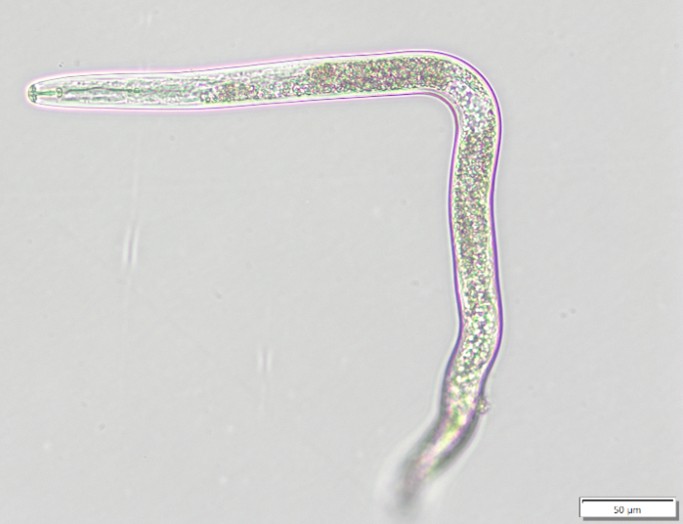How do pre-plant soil treatments improve growth and control nematodes in cherry orchards?
Pre-plant soil treatments, including fumigants, nematicides and organic amendments, improve tree growth and reduce harmful nematode populations, offering promising solutions for managing orchard replant disease in Michigan cherry systems.

The following study was conducted between 2022 and 2023 at the West Central Horticulture Research Station in Hart, Michigan (Figure 1), a site well-known for its relevance to local cherry production. This research station, located in Oceana County, provides conditions representative of typical cherry-growing environments in the region, featuring loamy sand soil previously cultivated with tart cherries.
This two-year field study conducted by Michigan State University researchers explored critical pre-plant soil management strategies for cherry orchards. The research focused on two specific cherry cultivars, 'Emperor Francis' and 'Ulster', both grafted to 'Mahaleb' rootstock, to understand how different soil treatments impact tree growth and nematode community dynamics in a replanted orchard setting. This research was conducted in collaboration with Michigan State University Extension, which provides science-based solutions to Michigan communities.
Replant disease challenge
Cherry orchard replant disease represents a significant economic threat for farmers. When new cherry trees are planted in soil previously used for stone fruit cultivation, they often experience severe growth limitations. Research indicates potential yield reductions up to 25%, which in Michigan translates to approximately $9 million in potential annual losses. The disease manifests quickly, with symptoms appearing within the first three months after planting, characterized by stunted growth, reduced root biomass and compromised overall tree health (Figure 2). Plant-parasitic nematodes, particularly root lesion nematodes (Figure 3), are primary contributors to this complex agricultural challenge.

Chemical treatments
The study investigated two primary chemical approaches to nematode management. Telone C-35 fumigation provided an immediate solution, delivering rapid control of root lesion nematodes and significantly improving early tree growth metrics. In the first year, this treatment led to significantly increased trunk cross-sectional area and canopy height in both cultivars (Figure 4). However, the nematode suppression was not sustained long-term, indicating the need for complementary strategies.
Velum Prime emerged as a more consistent treatment, showing exceptional promise. This fungicide/nematicide maintained root lesion nematode reproduction factors below one throughout both years for both cherry cultivars. Its dual functionality provides comprehensive underground pathogen management, supporting more stable tree development over time.
Organic amendment strategies
The research explored organic amendments as an alternative management approach. The combined application of Seed Starter 101, Dairy Doo and straw mulch demonstrated remarkable results. In the first year, this treatment reduced the root lesion nematode reproduction factor to less than one while simultaneously showing the highest reproduction factor for beneficial bacterivore and fungivore nematodes.
These organic amendments work by improving soil structure, increasing moisture retention and creating a more diverse microbial environment. While their effects might not be immediately apparent, they contribute to long-term soil ecosystem stability and support beneficial nematode populations.
Step-by-step guide for managing nematodes in cherry orchards
Year 1: Establishing your orchard
1. Pre-plant soil fumigation
- Use Telone C-35 in late fall (November recommended).
- Apply to a depth of 45 centimeters to reduce nematode populations.
- Benefit: Helps trees establish quickly with reduced pest pressure.
2. Planting and soil preparation
- Add organic materials like seed starter, dairy manure or straw mulch.
- Recommended application rate: 5 pounds per tree.
- Benefit: Boosts soil health and provides initial nematode control.
Year 2: Maintaining and adapting
1. Regular monitoring
- Sample soil in the spring (Figure 5).
- Check for:
- Plant parasitic nematode levels.
- Beneficial nematodes (bacterivores and fungivores).
- Overall soil health.
2. Adjusting treatments
- Continue using Velum Prime as needed.
- Rotate or add organic materials based on soil health and pest levels.
- Adjust strategies depending on monitoring results.
Long-term plan: Keeping your orchard healthy
1. Integrated nematode management
- Use a mix of chemical and organic solutions.
- Avoid relying on just one method to maintain soil balance.
2. Sustainable practices
- Focus on reducing chemical use while improving soil health.
- Build a resilient orchard by supporting natural ecosystem processes.
For more detailed information, the full article of this project is available at “Preplant Soil Treatments Influence Tree Performance and Nematode Dynamics in Replanted Cherry Orchards.



 Print
Print Email
Email